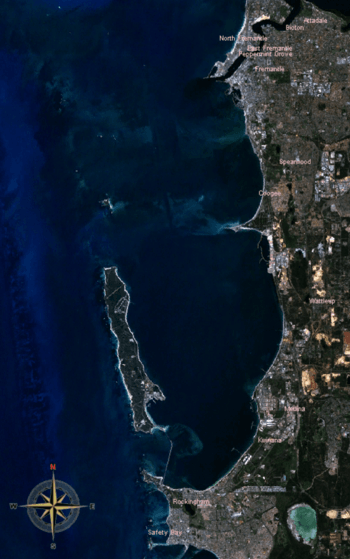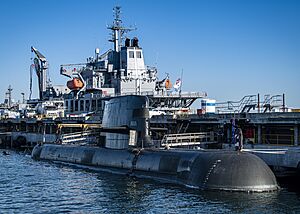Garden Island (Western Australia) facts for kids

Garden Island and Cockburn Sound from space (NASA World Wind)
|
|||||||||||||||
| Geography | |||||||||||||||
|---|---|---|---|---|---|---|---|---|---|---|---|---|---|---|---|
| Location | Indian Ocean | ||||||||||||||
| Coordinates | 32°11′39″S 115°40′27″E / 32.19417°S 115.67417°E | ||||||||||||||
| Area | 11 km2 (4.2 sq mi) | ||||||||||||||
| Administration | |||||||||||||||
| Demographics | |||||||||||||||
| Population | 772 (SAL 2021) | ||||||||||||||
|
|||||||||||||||
Garden Island is a long, thin island about 10 kilometres (6 mi) long and 1.5 kilometres (0.9 mi) wide. It lies about 5 kilometres (3 mi) off the coast of Western Australia. A man-made causeway and bridge connect it to the mainland.
The local Noongar people call the island Meandup or Meeandip. They have stories about walking to the island long ago. This was when sea levels were much lower.
Like nearby Rottnest Island, Garden Island is made of limestone. It has a thin layer of sand on top. This sand built up when the sea level was low.
About 7,000 years ago, after the last Ice Age, the sea level rose. This cut Garden Island off from the mainland. Since then, the island has been quite isolated.
The Royal Australian Navy has its biggest fleet base here. It is called Fleet Base West, or HMAS Stirling. It is located on the southeastern side of the island. This part faces Cockburn Sound. In 2016, about 720 people lived at the naval base.
Garden Island is important for its natural environment. It is listed on the Commonwealth Heritage List. The island is also home to a group of tammar wallabies.
Contents
Island's Early History
Dutch maps from 1658 showed the island, but they did not name it. Three Dutch ships were in the area that year. These were the Waekende Boey, the Elburg, and the Emeloort.
Later, in 1697, Willem de Vlamingh visited the region. After his visit, charts of the "Southland" were published. These charts clearly showed the island's outline.
How Garden Island Got Its Name
In 1801, French ships visited the area. One ship was the Naturaliste, led by Captain Jacques Felix Emmanuel, Baron Hamelin. He named the island Ile de Buache. This name honored Jean Nicolas Buache, a mapmaker in Paris.
The island got its current name, Garden Island, in 1827. This was given by Captain James Stirling. He was believed to have planted a garden there. He also released a cow, two ewes, and three goats. He chose an area with good grass and water.
However, some historians say Stirling used the name Garden Island even before planting anything. They believe he named it because it protected Cockburn Sound. This was similar to how the Isle of Wight, known as the "Garden Isle," protected the waters near Portsmouth in England.
First Settlements and Uses
Stirling came back to the area in 1829. He claimed Garden Island as part of his land grant. This grant was for 100,000 acres. He also claimed any livestock left from his earlier visit.
The first group of 450 settlers named their town Sulphur Town. Sulphur Bay and Careening Bay were key places for ships. They were used for anchoring and unloading cargo. This continued until 1897. That year, Fremantle's inner harbor was finished.
In 1907, a company called Peet & Co divided land at Careening Bay. They created 83 building plots. After World War I, the area became a holiday spot. People built wooden cottages there.
Garden Island During World War II
During World War II, Garden Island became very important. Gun batteries were placed on the island. These guns were part of a defense system. They protected the Fremantle Harbour facilities.
Challenger Battery
The first gun battery, called the Challenger Battery, was built in 1942. It had two large 155 mm guns. These guns were supplied by the United States. They were set up to protect Garden Island, Cockburn Sound, and the Challenger Passage. The battery was ready by April 1943.
More permanent batteries were also built on the island. These were finished in October 1943. However, the Challenger Battery guns were removed in December 1944.
Scriven Battery
The largest battery on Garden Island was the Scriven Battery. It had two powerful 9.2-inch guns. These were like the guns at the Oliver Hill Battery on Rottnest Island.
Building started in 1943. It included tunnels and rooms. There were places for shells, ammunition, and a power room. It also had a plotting room and command post. But the risk of attack lessened as it was finished. So, the battery and its guns were kept in reserve. The battery was officially closed in 1963, and the guns were taken apart.
Secret Training Base
During World War II, Careening Bay Camp was a secret training base. It was used by the Services Reconnaissance Department (SRD). This group was also known as "Z Special Unit".
The base was officially called the Special Boat Section. Operatives learned to use special folding kayaks called folboats. They also trained with top-secret British mini-submarines. These included the "Motorised Submersible Canoe" ("Sleeping Beauty") and the "Welman" and "Welfreighter" submarines. SRD teams from Careening Bay Camp went on secret missions. They went into areas controlled by Japan.
After the war, Garden Island became a holiday resort again. It also became home to the RAN Reserve Fleet.
In 1966, a study looked into building a naval support base on the island. The government approved this idea in 1969. Construction of the 4.3 kilometres (2.7 mi) Garden Island causeway began in 1971. It was finished in 1973.
The naval facility was completed in 1978. That same year, HMAS Stirling officially became a unit of the Royal Australian Navy. Stirling, also known as Fleet Base West, grew bigger. It became the main naval base on Australia's west coast. This was part of the "Two-Ocean Policy."
As of 2008, HMAS Stirling is home to five frigates. It also houses all submarines of the Royal Australian Navy Submarine Service. The headquarters for the Australian Submarine Service is at this base. A Clearance Diving Team is also based there.
Since the base was built, public access to the island has been limited. As of June 2010, the public cannot usually enter via the causeway. You need to be sponsored by the military to get in. Access by sea is also restricted. Private boats can use moorings, but only during daylight hours.
The Navy has worked to remove animals that were not native to the island. All native animals on Garden Island are now protected.



